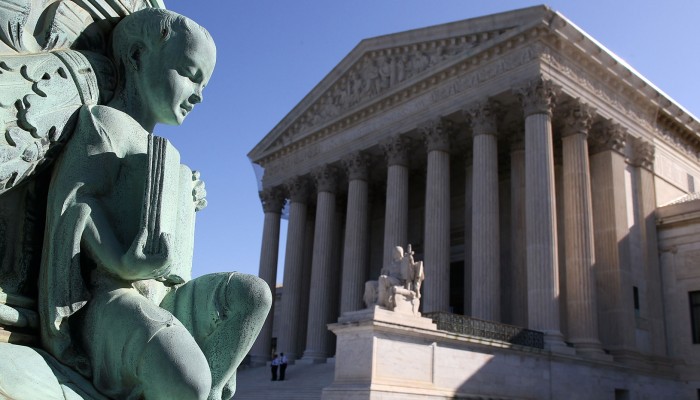A Second Amendment case decided by the Supreme Court Monday was originally expected to pit the liberal and conservative justices against one another, but it didn’t quite work out that way.
It has been 10 years since the Supreme Court issued its last big Second Amendment decision, and New York State Rifle & Pistol Association v. City of New York was supposed to break the silence. Some feared and others hoped that it would bring about an enlarged “right to keep and bear arms,” assisted by new appointees to the recomposed Court. Instead, the justices sent the case back to the lower courts for further proceedings.
Despite the lack of a substantive ruling, there are still some indications about what the future might hold. First, the case foreshadows more Second Amendment litigation at the Supreme Court — and probably soon. Second, it highlights that there still is nuance and restraint at the high court when it comes to guns, and that could lead to moderation.
The case involved a quirky policy in New York City that had barred handgun owners from taking their weapons to second homes and shooting ranges outside the city. That rule, the plaintiffs argued, violated their Second Amendment rights. After the landmark 2008 Supreme Court decision in District of Columbia v. Heller, law-abiding citizens have a right to possess a handgun in the home for self-defense. Ancillary to that right, the challengers argued, was a right to transport a handgun to one’s home and to train to use it.
Court watchers thought the plaintiffs’ chances were good. But after the Court accepted the case, New York City revised its policy, permitting firearm transport out of the city, and then New York State passed a law setting statewide standards that would prevent the city from reinstating the old policy. Those changes provided the plaintiffs the relief they sought.
They nonetheless pressed on with their case, raising new angles to keep it alive. Might the old law still be “live” for the purposes of receiving damages, even if they didn’t ask for damages in the lower courts? Was the new law unconstitutional because it didn’t permit them to stop wherever they wanted on their way to or from the shooting range?
It became increasingly apparent that the plaintiffs bringing the case — including a group affiliated with the National Rifle Association — really wanted another groundbreaking Second Amendment decision. But on Monday, six justices — including Chief Justice John Roberts and Justice Brett Kavanaugh — refused their entreaties, concluding that the dispute had already been resolved. In legalese, it was moot.
The fact that the Court accepted this case in the first place signals that more gun cases are to come. New York City successfully defended the policy in the lower courts. In the years after the Heller decision, those lower-court decisions generally served as the final word. The Supreme Court refused dozens and dozens of requests to intervene in Second Amendment cases before Justices Neil Gorsuch and Brett Kavanaugh joined the Court. It may be no coincidence that the New York case was accepted just after Kavanaugh replaced Justice Anthony Kennedy, who has been credited with insisting on cautionary language in the Heller majority opinion.
Moreover, Kavanaugh contributed a short concurrence and Justice Samuel Alito, joined by Justices Clarence Thomas and Gorsuch, wrote a dissent that made explicit their desire to intervene in another Second Amendment case. In Kavanaugh’s words, they are “concern[ed] that some federal and state courts may not be properly applying Heller and McDonald [the case that applied Heller to state and local governments]. The Court should address that issue soon.”
And indeed, after Monday’s ruling came down, no fewer than 10 Second Amendment cases vying for consideration were distributed for the Court’s May 1 conference, during which the justices vote on whether to add to their October 2020 term docket. Some of those cases raise bigger issues than the ones raised by the New York one, like the constitutionality of bans on assault weapons and large-capacity magazines, or restrictions on carrying handguns in public.
So we are likely to see more Second Amendment litigation at the high court, but that does not mean that gun violence prevention advocates should despair, in part because of nuance in Kavanaugh’s concurrence and Alito’s dissent.
The four justices who wrote or joined either of those opinions clearly think that lower courts should be striking down more gun laws or at least scrutinizing them differently. Reading between the lines of their opinions, however, those justices might not agree about precisely how Second Amendment doctrine should look — whether, for example, judges should decide cases solely based on text, history, and tradition, or whether they should also consider modern-day gun violence and the effectiveness of efforts to reduce it. Answers to doctrinal questions like that will be essential for future efforts to combat today’s evolving gun violence problems.
Moreover, an increased appetite among four justices doesn’t mean that gun regulations will fall like dominoes. Yes, it takes the vote of just four justices to accept a new case, but it takes five to reach the majority needed to rule on it. Even if those four justices reach a consensus about expanding the Second Amendment, they will need a fifth vote if they want to set Second Amendment doctrine on a new course.
The views of Roberts thus will be pivotal, as he is the likeliest swing vote in future Second Amendment cases. In this instance, he provided nary a clue as to his views on the bigger Second Amendment questions. But he did show restraint, joining Justices Ruth Bader Ginsburg, Stephen Breyer, Sonia Sotomayor, Elena Kagan, and Kavanaugh, and refusing to expand the Second Amendment at the expense of another important constitutional principle — the “mootness doctrine,” under which courts won’t decide a case if the dispute no longer exists. We will have to wait a little longer to see whether that restraint carries over to the next big Second Amendment case.
Eric Ruben is an assistant professor of law at SMU Dedman School of Law and a Brennan Center fellow. He co-filed a friend-of-the-court brief on behalf of neither party in New York State Rifle & Pistol Association v. City of New York.

